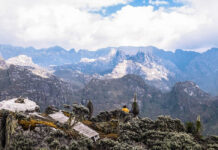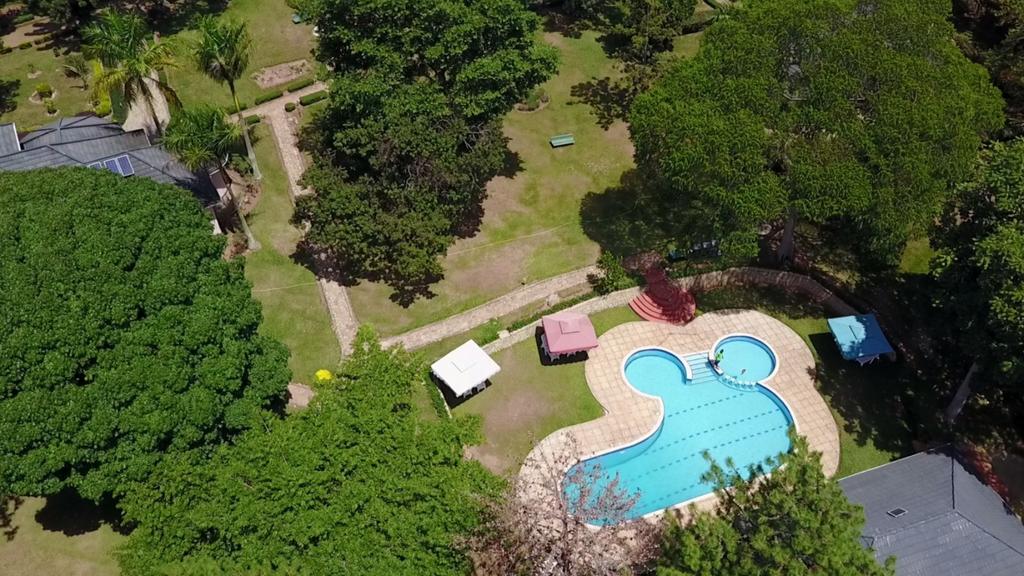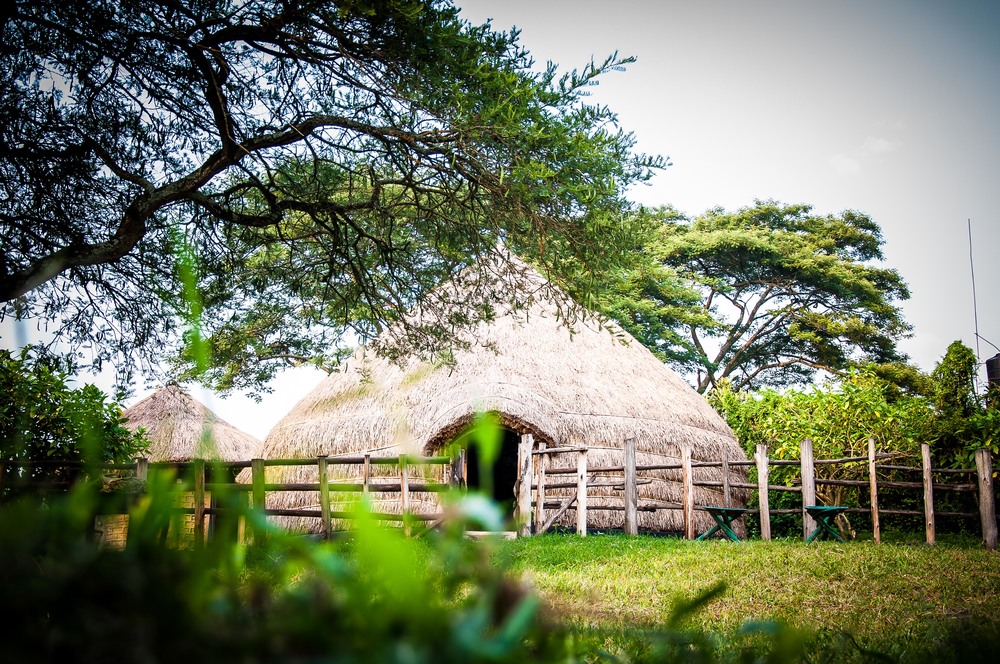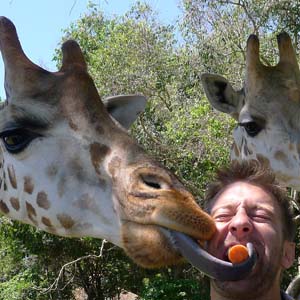Having explored the wonders of Uganda for a few months while working in Jinja, Jeri Pavlista decided to experience more of Uganda with a self-drive adventure trip. Take time to read his enthusiastic safari report of a 10-day classic trip.
During my time in Uganda, after a couple of months in the eastern town of Jinja working for the Australian based NGO Care 4 Kids-Uganda, I was planning a Safari trip to adventure more of Uganda and to sum up my stay abroad. In travel guides and on the internet you will find lots of warnings in regard to self-driving in Uganda or Africa at large. It’s all about the notorious traffic jams, the irresponsible behavior of your fellow road users and bad road conditions. But having prior read the stories of other travellers before me and given the fact I had been living in Uganda for almost two months, I decided it would be the best way to explore the country, despite all the possible challenges. Luckily, my travel partner agreed.
During the course of ten days of our safari, we drove over 1,800 kilometres in our 4×4 Rental Car visiting towns, small country villages and national parks. We followed mostly the tarmac main roads, but whenever possible we took the murram roads crossing the country side. This may be not as fast, but you are able to see much more including remote areas. In the national parks we were able to spot lots of wildlife this beautiful east African country has to offer, alongside the road ways we discovered Ugandan daily life. These were demanding but rewarding and above all very beautiful kilometres.
Day 1: Drive from Kampala – Kibale Rain Forest Park
This morning up early ready to take up the drive through these challenging roads, but navigating the morning traffic jam in Kampala in a car I did not drive before, is a bit too challenging for me. So, our classic adventure starts at one of the exit roads of the capital, Driving keeping left side of the road – opposite to my home country – is easier than I thought and being in Uganda for some time now, I feel comfortable on these roads right away. We are covering great distances on the fairly quiet main road and after a Rolex for lunch on the side of the road we decide to leave the tarmac and try the red murram roads. The road is bumpy and narrow; boda-boda’s use every available centimetre to overtake us, children wave enthusiastically at the two mzungu’s. Navigating is not easy here and our average speed drops spectacularly, but this is exactly why we chose for a self-drive in Uganda.
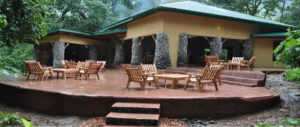
Day 2: Trekking Chimpanzees in the rain Forest – Ruboni Community Camp
Flamboyant yelling, somewhere deep in the jungle, within seconds the forest is full of loud and impressive noise. These are the human closest cousins; the chimpanzees we are after on our hike today. Straight forward through the wet shrubs and huge trees we try to keep close with our guide, looking for these primates. Before we know it we find a single male sitting right in front of us. It quickly walks away, but we manage to follow him to a couple of his family members. Unfortunately, because of the wet conditions they are high up in the trees, but with our zoom lenses and binoculars we are able to observe them quite well. We find one laying on a branch, scratching her belly, slowly raising herself to look around, her movements look so very human.
Day 3: Ruboni Community Camp
Very early before sunrise we leave our camp for a six hour hike in the Rwenzori Mountains also known as the mountains of the moon. Surrounded by lush green foliage we climb steep tracks, with considerable more effort compared to the locals living here. These hills are full of large plantations of matooke, cassava, potatoes, palm trees and ferns, the surroundings are incredibly green. When we reach the top we were aiming for we find the ‘King of the Clouds’ mountains living up to their name, nevertheless the views are impressive. The massive 5,000 meter high peaks on the Uganda-Congo border on one side, the plains of the Western Rift Valley on the other. Back on our descent, the guide suddenly jumps into the dense shrubbery. Wondering what he is up to, we see him returning with a chameleon. Such a strange little animal. Slowly black spots appear on his back while he is struggling to find support on my arms, his eyes moving around, strangely independent from each other.
Day 4: Ruboni Community Camp experience – Queen Elizabeth National Park

Before we proceeded with our journey to Queen Elizabeth National Park, our guide and a couple of locals show us the history and daily life of Ruboni Community and the Bakonjo people living here. Life is tough here, that is certain. “Everybody is a farmer to survive”, according to our guide, first you need to grow your own food before you can work on other tasks. People are working hard between the matooke and cassava plants, carrying heavy sacks full of food or fire wood on their heads. Even little children are supposed to contribute, for many of them there is no money the send them to school. Although not very many guests are visiting this place, tourism can be an extra source of income for communities like these, for the benefit of all.
Day 5: Queen Elizabeth National Park
In our early morning game drive to the northern part of the park – Kasenyi track was followed by boat trip on the Kazinga Channel in the afternoon, we are lucky to spot very many animals. Maybe the spells by the medicine-man we met yesterday work their magic for us. With the sun rising we see the Uganda kob’s and warthogs on the savannah, but also manage to find two lions. Quickly they run away when they notice the safari vans rushing in, but still we saw them. During the boat trip the amount and proximity of the wildlife is overwhelming. Besides the large numbers of different birds, we see dozens of elephants, hippo’s and buffalo’s, all looking for refreshment on these shores. With our boat we can get very close and observe these beautiful animals and their offspring. This is impressive. This is like watching BBC’s Planet Earth in real life.
Day 6: Tree Climbing Lions – Bwindi Impenetrable Forest
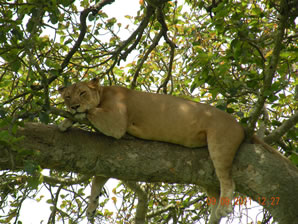
Lots of driving today to reach our next destination, the Isasha sector south of Queen Elizabeth national park is the only place in the world where you can witness the tree climbing lion. About 2 hours drive from the northern part, the view here was world class, saw a whole pride roaming up in the branches of the fig tree, in company of a local guide we drove around the tree with lots of spectacular views. Quickly we preceded our journey to Bwindi Impenetrable rainforest. The roads vary between brand new tarmac and narrow tracks full of rocks, the speed between 80 and 5 kilometres per hour. Enough time to admire the beautiful panoramas and to see the daily life of the Ugandans alongside the roads.
Day 7: Bwindi Impenetrable ancient rain Forest
Today we wake up to Uganda’s star attraction; we are entering the impenetrable ancient rain forest to look for the world’s rare mountain gorillas. In a process taking several years some of the communities living in these woods are habituated to humans visiting them on a daily basis. The family we are about to visit appears to be very close to the trailhead, after ten minutes of crawling through the jungle we already face two silverbacks the dominant male. Only a couple of meters separate us from these impressive animals, who do not seem to bother our presence and just continue feeding on leaves. Within the allowed timeframe of one hour we manage to find the rest of the family members as well, including two mothers with their babies on their backs. Despite their appearance, the gorillas are outstandingly swift climbing up and down the trees, it gets even more impressive when one of the silverbacks gets up on his hind legs and strikes his chest. It is truly beautiful to be able to observe these animals in their natural habitat; this surely is the climax of our journey.
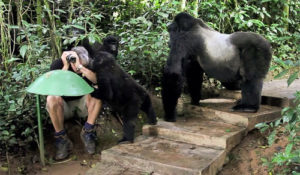
Day 8: Bwindi Impenetrable Forest – Lake Mburo National Park
Wake up for more lots of kilometres to drive on the main road ahead of us today to reach our next and final destination, so we decide to make a detour on the shores of Lake Bunyonyi. The twenty kilometre track is winding and hilly, full of rocks, mud and potholes and takes us almost one and a half hour to complete, but it is a nice test of our driving skills and the views are definitely worth it. The contours of the lake are erratic, the surrounding hills green. Alongside the road people are working the fields or carrying their crops, surprised they look at the two mzungu’s passing by.
Day 9: Lake Mburo National Park
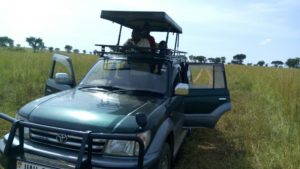
Southwest of the country on the wooded hills around Lake Mburo we find our very last chances to spot some wildlife. Besides the buffalo’s and warthogs we already saw at Queen Elizabeth National Park, we mainly see zebra’s, impala’s and the Iland the world’s largest antelope, unfortunately the giraffes do not show themselves today. To get the most of our time here we decide to go for a night game drive as well, to add some of the nocturnal animals in this park to our list. Accompanied by a giant searchlight our guide hangs out of the window to look for them, and with great success. “Stop! Quick, quick! Turn around here!” After a couple of confusing instructions we find a beautiful leopard in the beam of our searchlight. After the buffalo’s, elephants and lions we found the fourth of the ‘big five’! The leopard is heading for an open field packed with impala’s and zebra’s, its dinner for today. When we continue our drive, we find a couple of hyenas on the opposite site of the same field; it is going to be another hard night for the prey animals…
Day 10: Lake Mburo National Park – Entebbe
Wow, for the second time during this journey we cross the equator, and return to the Northern Hemisphere. In the last kilometres of our trip we get to know the ‘white angels’, the traffic police in their bright white uniforms. Of course they find something wrong and one of them starts threatening us, we are supposed to go to court and may even get imprisoned. We knew things like these can happen on Ugandan roads, but still it feels very uncomfortable. A ‘good cop, bad cop’ story evolves with the arrival of a second policeman, this one surely being the good one of the two. He is apologizing and explaining he does not want us to have a bad impression on Uganda for this and that the other policeman is perhaps a bit too serious in his work. So we agree to deal with it the African way, I give the guys some money to buy a soda, promise to be more careful next time and thank them for their understanding. A bit irritated on this, but also knowing we have something to tell back home, we continue our trip to Entebbe.
Day10 Equator Line
For the last time we leave the main road for the rural murram roads and cross Waiya Bay by ferry to reach Entebbe, avoiding Kampala (and more potential encounters with the traffic police) by doing so. Having returned safely, I can say self-driving was the best option for travelling Uganda. Sure, you will meet some challenges on the road, but in the end this is all worth it, this Uganda safari trip was very rewarding. Every kilometre we drove brought new experiences and stories, adding to the adventure, much more than when hopping on a bus, with nothing to do but waiting until you reach your next stop. As the famous saying goes; the journey is the destination.




